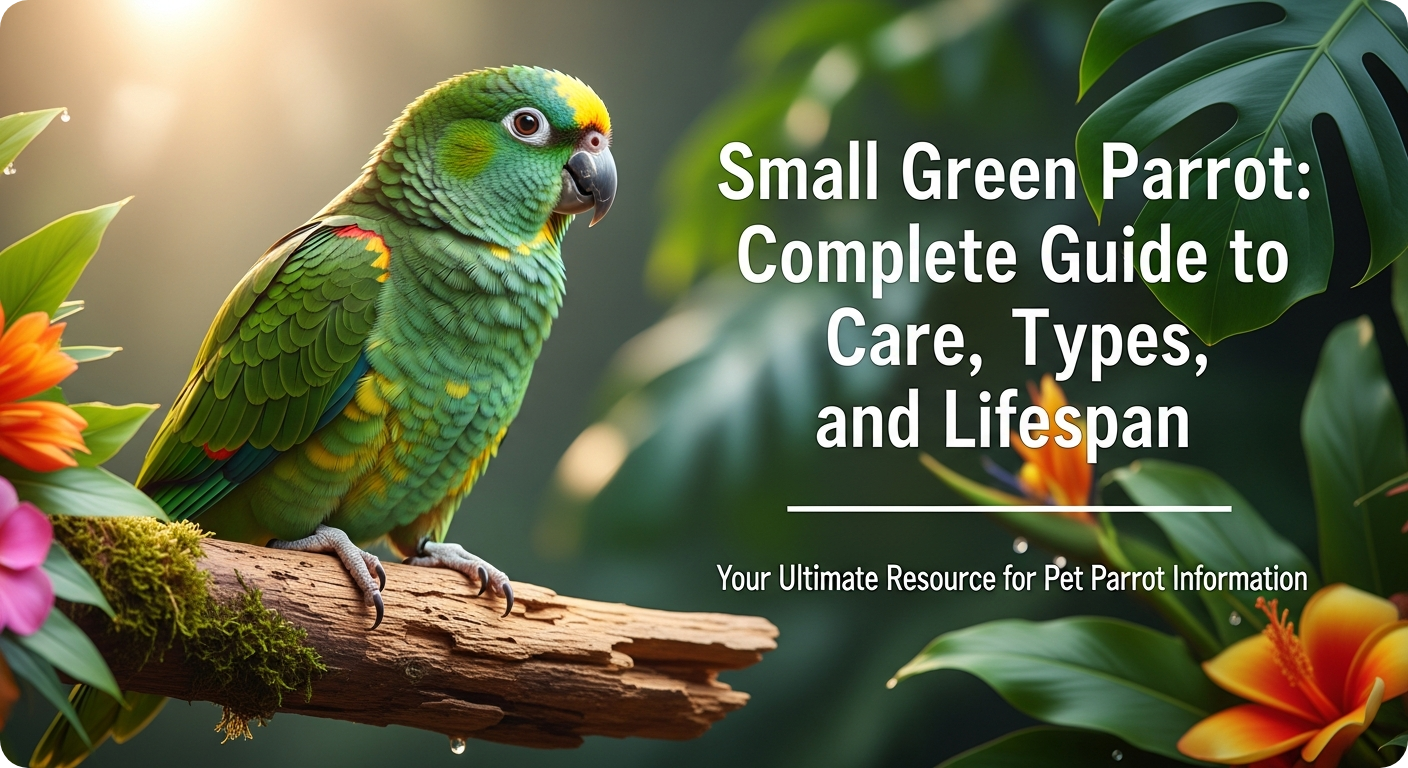

A small green parrot is more than just a pet; it’s a vibrant spark of life, a clever companion, and a beautiful addition to any home. These feathered friends are famous for their stunning green plumage, their brainpower that rivals much larger animals, and their personalities that are often far bigger than their small bodies.
But owning one of these intelligent birds is a big responsibility. This ultimate guide is here to walk you through every single step. We will explore the different types of small green parrots, break down their exact care needs in simple terms, and give you the secrets to helping them live a long, happy, and healthy life by your side.
What Exactly is a Small Green Parrot?
When we talk about a small green parrot, we are referring to a group of petite-sized parrots, typically measuring between 4 to 12 inches in length, whose plumage is predominantly a brilliant green. This green color acts as perfect camouflage in their natural forest habitats. Many species are accentuated with stunning splashes of blue, yellow, red, or orange on their heads, wings, or chests.
These birds are much more than just a pretty face. They belong to the parrot family, known scientifically as Psittacines, which means they share key traits with their larger cousins like macaws and cockatoos. They have a strong, curved beak perfect for cracking nuts and seeds, and zygodactyl feet—two toes facing forward and two backward—that give them an exceptional ability to climb and hold objects.
A small green parrot is often celebrated for its intelligence and playful, social nature. They can learn tricks, solve puzzles, and some can even learn to mimic human speech, making them engaging and entertaining companions.
Popular Types of Small Green Parrots

The term “small green parrot” covers a wonderful variety of species. Each one has its own unique look, personality, and care requirements. Here is a closer look at some of the most popular types
Budgerigar (Budgie or Parakeet)
- Scientific Name: Melopsittacus undulatus
- Size: 6-8 inches
- Lifespan: 7-15 years
The Budgerigar, often called a budgie or parakeet, is arguably the most popular small green parrot in the world. In the wild, they are naturally green and yellow.
However, through captive breeding, they now come in a rainbow of colors like blue, white, and grey. Budgies are social, cheerful, and can be excellent talkers, building vocabularies of hundreds of words. They are a fantastic choice for first-time bird owners due to their friendly nature and relatively simple care needs.
Pacific Parrotlet
- Scientific Name: Forpus coelestis
- Size: 4-5 inches
- Lifespan: 15-20 years
Don’t let their tiny size fool you! Pacific Parrotlets are often described as “pocket parrots” with the personality of a much larger bird.
They are fearless, curious, and can be very affectionate with their owners. Wild Pacific parrotlets are green with a dusty grey cast, though many color mutations exist. They can learn to talk, though their voices are small and squeaky
. They are known for their feisty attitudes and may become territorial if not handled regularly.
Lovebird
- Scientific Name: Agapornis species
- Size: 5-7 inches
- Lifespan: 15-30 years
Lovebirds are stocky, energetic small green parrots known for their deep pair bonds—often sitting preening their mate for hours, which is how they got their name. Species like the Fischer’s lovebird are vividly green.
The Abyssinian lovebird is a small green parrot with a distinctive red beak and forehead (in males). They are playful and love to shred toys. While not known for talking, they are very expressive with a variety of chirps and calls.
Green-Cheeked Conure
- Scientific Name: Pyrrhura molinae
- Size: 10 inches
- Lifespan: 15-25 years
A small green parrot with a ton of personality! The Green-cheeked Conure is a favorite for its playful, clownish behavior and relatively quiet nature compared to other conures. They are mostly green with a grey head, bright green cheeks, and a maroon tail.
They love to play, cuddle, and can be quite comical. Their talking ability is limited, but they are intelligent and can learn many tricks.
Quaker Parrot (Monk Parakeet)
- Scientific Name: Myiopsitta monachus
- Size: 11-12 inches
- Lifespan: 20-30 years
The Quaker Parrot is a brilliant and talkative small green parrot. They are known for their exceptional ability to mimic human speech and sounds clearly.
They have bright green backs, wings, and a pale greyish breast that looks like an old-fashioned Quaker’s waistcoat. Quakers are also unique for being the only parrots that build large, communal stick nests in the wild. They are highly social but can be one-person birds, forming a very strong bond with their favorite human.
Important Note: It is crucial to check your local laws, as they are illegal to own in some U.S. states like California and Pennsylvania due to concerns about them becoming invasive pests.
Lineolated Parakeet
- Scientific Name: Bolborhynchus lineola
- Size: 6-7 inches
- Lifespan: 15-20 years
The Lineolated Parakeet, or “Linnie,” is a calm and quiet small green parrot, making it an excellent choice for apartment living.
They are mostly green with dark black barring (lines) on their back and wings. Unlike many parrots, they have a unique shuffling movement and often prefer climbing to flying. They are gentle, affectionate, and their soft chattering is rarely disruptive.
Senegal Parrot
- Scientific Name: Poicephalus senegalus
- Size: 10 inches
- Lifespan: 20-50 years
The Senegal Parrot is a slightly stockier small green parrot known for its calm demeanor and intelligence. They have a charcoal-grey head, green wings and back, and a vibrant V-shaped orange or yellow patch on their belly. Senegals are known for being quiet but very playful and comical. They tend to bond strongly with one person and can be shy around strangers.
Choosing Your Small Green Parrot: A Quick Comparison
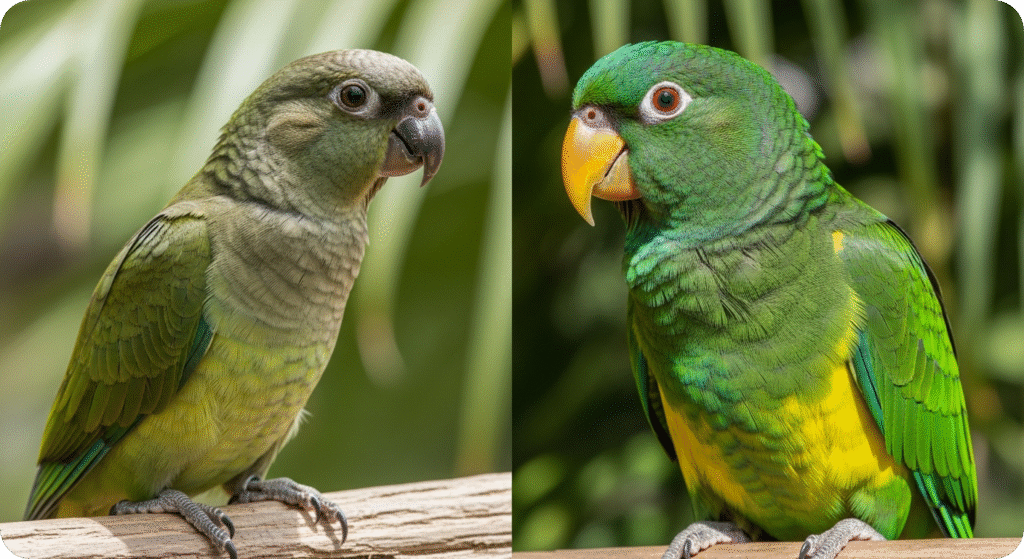
To help you decide which small green parrot might be your perfect match, here is a simple comparison table
Small Green Parrot Comparison Chart
| Bird Species | Best For | Talking Ability | Noise Level | Key Personality Trait |
|---|---|---|---|---|
| Budgerigar | Beginners & Families | Excellent | Low-Moderate | Social and Cheerful |
| Lineolated Parakeet | Apartments & Quiet Homes | Limited | Very Low | Calm and Gentle |
| Lovebird | Owners Wanting a Pair | Low | Moderate | Affectionate and Energetic |
| Green-Cheeked Conure | Playful Companionship | Limited | Low-Moderate | Playful and Clownish |
| Senegal Parrot | One-Person Bonds | Moderate | Low | Quiet and Comical |
| Pacific Parrotlet | Experienced Owners | Low-Moderate | Low | Fearless and Curious |
| Quaker Parrot | Talkative Companions | Excellent | Moderate-High | Intelligent and Loyal |
The Ideal Diet for Your Small Green Parrot
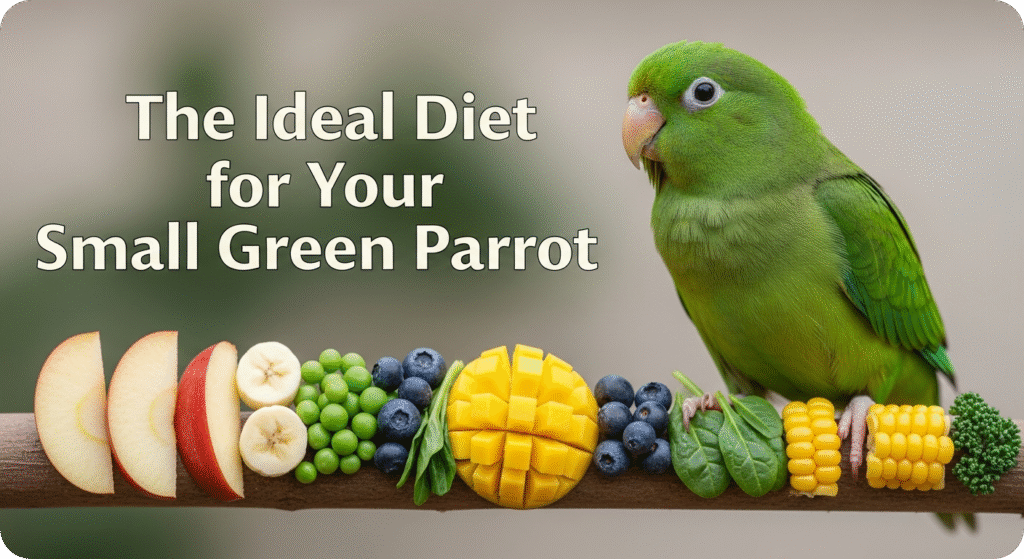
Feeding your small green parrot a balanced and nutritious diet is the single most important thing you can do to ensure it lives a long and healthy life. A poor diet is a leading cause of health problems and a shortened lifespan in pet parrots.
The Foundation of a Healthy Small Green Parrot Diet
- High-Quality Pellets (60-70% of diet): A formulated pellet should be the staple of your bird’s diet. Pellets are designed to provide a balanced mix of vitamins, minerals, and nutrients that seeds alone cannot offer. Look for organic pellets with no artificial colors or preservatives.
- Fresh Vegetables (20-30% of diet): Offer a wide variety of fresh, washed vegetables daily. Excellent choices include:
- Dark leafy greens (kale, spinach, Swiss chard)
- Broccoli and cauliflower
- Carrots and sweet potatoes (cooked)
- Bell peppers (all colors)
- Peas and green beans
- Fruits and Treats (5-10% of diet): Fruits are great for treats and added vitamins but should be given in moderation due to their high sugar content. Good options are apples (no seeds), pears, bananas, berries, and melon. Seeds and nuts should also be given only as occasional treats, as they are high in fat.
Foods That Are Dangerous for Your Small Green Parrot
You must never feed your bird the following toxic foods:
- Avocado: Contains persin, which is highly toxic to birds.
- Chocolate and Caffeine: Can cause fatal heart and nervous system problems.
- Alcohol: Is extremely dangerous for a bird’s small body.
- Onions and Garlic: Can cause anemia by destroying red blood cells.
- Fruit pits (e.g., cherry, peach) and apple seeds: Contain traces of cyanide.
Creating the Perfect Home for Your Small Green Parrot

Your bird’s cage is its safe territory—its nest, playground, and dining room all in one. Setting it up correctly is vital for its physical and mental health.
Selecting the Right Cage for Your Small Green Parrot
- Size: The golden rule is to buy the largest cage you can afford and fit in your space. As a minimum, the cage must be wide enough for your small green parrot to fully stretch and flap its wings without hitting the sides. For most small parrots, a cage measuring at least 18″ x 18″ x 24″ is a good starting point, but bigger is always better.
- Bar Spacing: This is a critical safety feature. For small parrots like budgies and parrotlets, the bar spacing should be no more than 1/2 inch to prevent them from sticking their heads through and getting trapped.
- Shape: Opt for a rectangular cage over a round one. Round cages can make birds feel insecure as they lack corners to retreat to for safety.
- Placement: Place the cage in a well-lit area of your home that is part of the family’s activity, like a living room, but against a wall for security. Avoid areas with direct sunlight, drafts from windows or doors, and the kitchen (where fumes from non-stick cookware can be deadly).
Essential Cage Accessories for a Happy Small Green Parrot
- Perches: Provide multiple perches of different diameters, shapes, and textures (natural wood, rope, cement) to exercise your bird’s feet and prevent sores.
- Food and Water Dishes: Use sturdy, easy-to-clean stainless steel or ceramic dishes. You should have separate dishes for pellets, fresh foods, and water.
- Toys! Toys are not a luxury; they are a necessity for a small green parrot’s mental health. Provide a rotating selection of:
- Shredding Toys: Made of bird-safe wood, paper, or cardboard.
- Foraging Toys: Toys that hide treats, encouraging natural foraging behavior.
- Noise-Making Toys: Bells and rattles for entertainment.
- Puzzle Toys: To challenge their intelligent brains.
Understanding Your Small Green Parrot’s Behavior
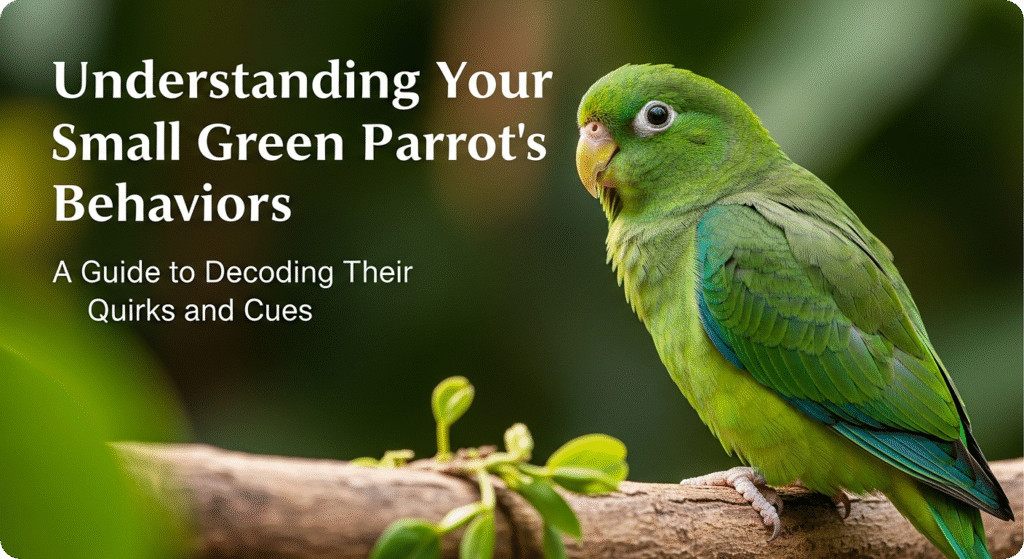
To live happily with a parrot, you need to speak a little of their language. Understanding their behavior is key to a strong bond.
The Social and Playful Nature of a Small Green Parrot
In the wild, parrots live in flocks. Your small green parrot will see your family as its flock and will crave social interaction. You should aim to spend at least 30 minutes to an hour of direct, out-of-cage interaction with your bird each day.
This can include training, playing, or simply letting them perch on your shoulder while you do chores. A lonely parrot can become depressed, leading to health and behavior problems.
Small Green Parrot Talking and Mimicry Skills
While not all parrots talk, species like the Budgerigar and Quaker Parrot are famous for their ability to mimic human speech. They don’t understand language in the way we do, but they learn to associate words with actions, objects, and emotions. Training requires patience, repetition, and positive reinforcement. Even non-talking species are very communicative through their body language and various chirps.
Normal vs. Concerning Small Green Parrot Behaviors
Healthy Behaviors:
- Active and alert during the day
- Preening (grooming feathers)
- Playing with toys
- Chirping, singing, or chattering
- Taking regular naps
Behaviors That Require a Vet Visit:
- Sitting fluffed up for long periods
- Loss of appetite or sudden weight loss
- Wheezing, sneezing, or tail-bobbing while breathing
- Feather plucking (creating bald spots)
- Lumps, bumps, or beak abnormalities
- Significant changes in droppings (color or consistency)
Training and Bonding With Your Small Green Parrot
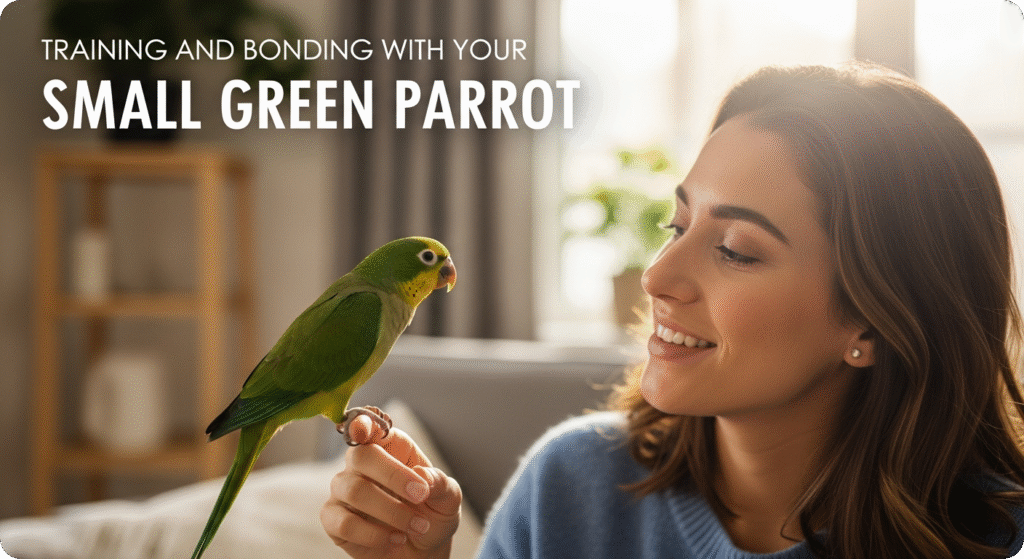
Building a strong bond with your small green parrot is one of the most rewarding parts of ownership. Training is the best way to do this.
Step-Up Training: The First Command
“Step-up” is the most important command you will teach your bird. It builds trust and is the basis for all other interactions.
- Place your hand in front of your bird, just above its feet.
- Gently press your finger against its lower chest, saying “Step up.”
- The natural reaction is for the bird to step onto your finger for balance.
- Immediately reward with a tiny, high-value treat (like a piece of millet) and verbal praise.
- Repeat this process multiple times a day in short, 5-minute sessions.
Building Trust with Your New Small Green Parrot
When you first bring your bird home, give it a day or two to adjust to its new cage without forcing interaction. Sit near the cage and talk softly to it. Once it seems comfortable, you can begin step-up training. Move at your bird’s pace and never force it to do something it’s scared of.
Ensuring a Long and Healthy Life for Your Small Green Parrot
The lifespan of a small green parrot can vary widely, but with excellent care, many live for decades. Their long life is a big commitment, so it’s important to get their care right from the start.
How Long Do Small Green Parrots Live?
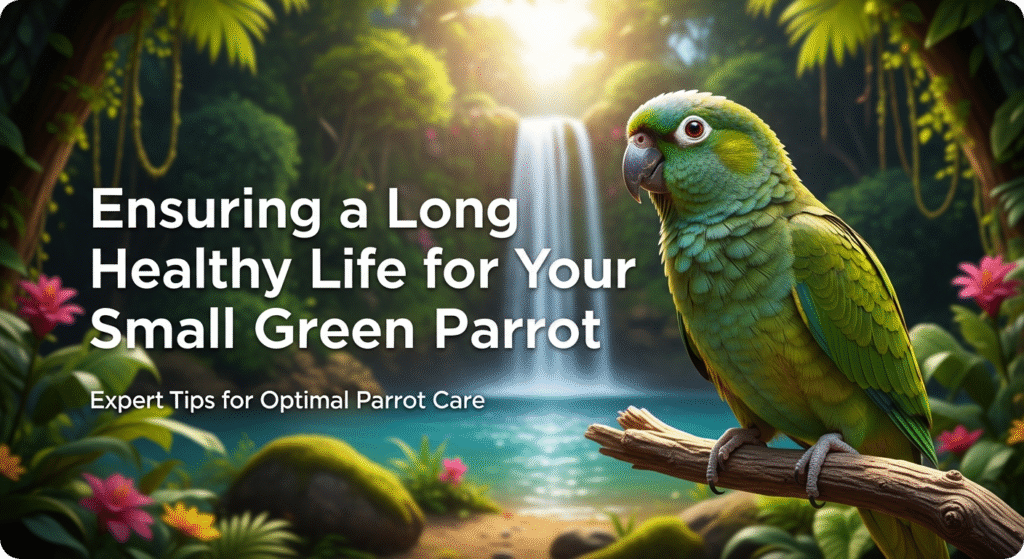
Here is a general guide to the lifespans of popular species:
Small Green Parrot Lifespan Guide
| Species | Average Lifespan in Captivity |
|---|---|
| Budgerigar (Budgie) | 7-15 years |
| Pacific Parrotlet | 15-20 years |
| Lovebird | 15-30 years |
| Green-Cheeked Conure | 15-25 years |
| Quaker Parrot | 20-30 years |
| Senegal Parrot | 20-50 years |
Top Tips for a Long Small Green Parrot Lifespan
- Provide a Balanced Diet: As discussed, this is the number one factor. Avoid seed-only diets, which lead to obesity and liver disease.
- Schedule Annual Vet Check-ups: Find an avian veterinarian (a bird specialist) for yearly wellness exams. They can catch health issues you might miss.
- Ensure Mental Stimulation: A bored parrot is an unhappy, unhealthy parrot. Rotate toys regularly and provide foraging opportunities to prevent negative behaviors like feather plucking.
- Prioritize Sleep: Parrots need about 10-12 hours of uninterrupted darkness and quiet each night. Use a cage cover if necessary to ensure they get proper rest.
- Promote Exercise: Allow for several hours of supervised out-of-cage time daily so your small green parrot can fly, climb, and explore in a safe space.
The True Cost of a Small Green Parrot
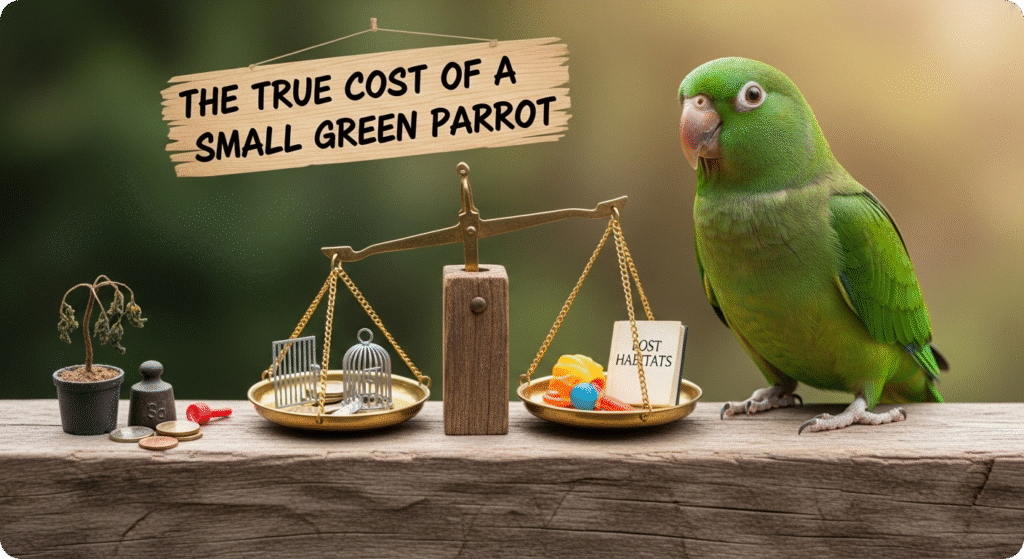
Owning a pet is a financial commitment. Here’s a breakdown of the potential costs involved in caring for a small green parrot.
Initial Setup Costs for a Small Green Parrot (One-Time Purchases)
- Bird Cage: $150 – $400
- Play Gym: $50 – $100
- Initial Set of Perches & Toys: $50 – $100
- Travel Carrier: $30 – $80
- Total Initial Cost: ~$280 – $680
Recurring Annual Costs for a Small Green Parrot
- High-Quality Pellets & Fresh Foods: $200 – $400 per year
- Toys & Replacement Perches: $100 – $200 per year
- Veterinary Care (Wellness Exam): $75 – $150 per year
- Total Annual Cost: ~$375 – $750
It is also wise to have an emergency vet fund of at least $500, as avian medical care for things like infections or injuries can be expensive.
Small Green Parrot: Is It Right for You?
The Good:
- Intelligent and Engaging: Their ability to learn and play makes them fascinating companions.
- Long-Lived: A long lifespan means a lasting friendship.
- Affectionate: A bonded parrot can be incredibly loving and loyal.
- Compact Size: They require less space than a dog or a large parrot.
The Challenges:
- Long-Term Commitment: A parrot is a commitment that can last decades, similar to raising a child.
- Daily Time Requirement: They cannot be ignored; they need daily interaction and care.
- Messiness: They flick food, shed feathers (dust), and will happily shred anything they can.
- Potential for Noise: While quieter than large parrots, they will chirp, squawk, and chatter, especially in the morning and evening.
Frequently Asked Questions About Small Green Parrots
Q1: What is the best small green parrot for a beginner?
A: The Budgerigar (Budgie) is widely considered the best small green parrot for beginners. They are relatively easy to care for, have a friendly and social nature, and are less expensive than many other species. Lineolated Parakeets are also a good choice for their calm demeanor.
Q2: Can all small green parrots talk?
A: No, not all of them can or will talk. Budgerigars and Quaker Parrots are the most renowned talkers among the small species. Others, like Green-cheeked Conures and Lovebirds, may learn a few words but are better known for their sounds and whistles.
Q3: Is it better to get one or two small green parrots?
A: This depends on your time and goals. If you are away from home for long hours, getting a pair can prevent loneliness. However, two birds will often bond closely with each other and may be less interested in interacting with you. If you want a strongly bonded pet, a single bird is often better, provided you can give it plenty of daily attention.
Q4: How noisy are small green parrots?
A: Noise levels vary. Budgies and Linnies have softer, constant chatters. Lovebirds and Conures can have louder, sharper calls. Quaker Parrots can be quite loud when they want to be. All parrots are most vocal at dawn and dusk.
Q5: What should I do if my small green parrot seems sick?
A: If you notice any signs of illness like lethargy, fluffing up, loss of appetite, or breathing problems, you should contact an avian veterinarian immediately. Birds are experts at hiding illness, so by the time they show symptoms, they can be very sick and need prompt medical care.
Q6: How can I get my small green parrot to trust me?
A: Trust is built with patience. Spend time near the cage, talk softly, and offer treats from your hand. Move slowly and let the bird set the pace. Forcing interaction will break trust. Positive reinforcement training with treats is the fastest way to build a bond.
Conclusion: Is a Small Green Parrot Your Perfect Pet?
Bringing a small green parrot into your home is a deeply rewarding experience that can bring years of joy, color, and companionship. However, it is a decision that should be made with care, research, and a deep sense of responsibility.
These are not low-maintenance pets; they are intelligent, emotional creatures that require daily care, mental stimulation, and social interaction. Their long lifespan means you are making a promise to care for them for many years to come.
If you have the time, patience, and resources to provide a loving and stimulating forever home, then a small green parrot will repay you with endless entertainment, a unique friendship, and the special privilege of sharing your life with a truly remarkable little being.

Leave a Reply